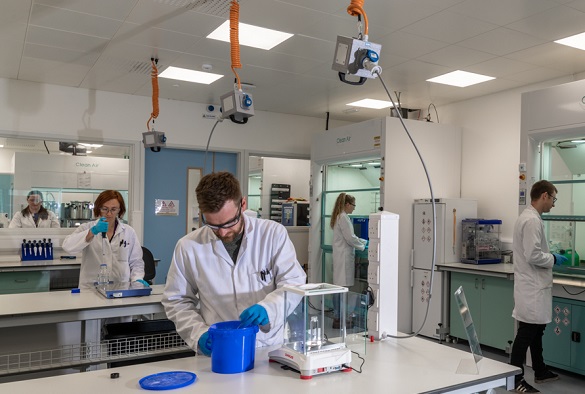Saving lives through long-acting injectable innovation

Professor Steve Rannard is Co-director of the Centre of Excellence for Long-acting Therapeutics. Steve leads a team of chemists in developing long-acting formulations for malaria prevention. For World Malaria Day, Steve and his group spent some time to explain how their innovative technology can revolutionise malaria prevention in low- and middle-income countries.
The theme for World Malaria Day 2022 is ‘Harness innovation to reduce the malaria disease burden and save lives.’ What innovations are CELT scientists developing to help the fight against malaria?
Our work involves the formulation of atovaquone, an existing medication used conventionally in combination with another drug for oral malaria chemoprophylaxis. Atovaquone is a poorly water-soluble drug, and has poor bioavailability when taken orally. Formulating this drug into solid drug nanoparticles (SDNs) allows us to create a product that readily disperses in water and allows us to achieve a high drug loading within an aqueous medium that can then be administered by injection. Delivering this formulation by either subcutaneous or intramuscular injection may provide enough drug to offer protection against malaria over a period of months, whilst current oral medications require daily dosing.
How does this technology work?
Solid drug nanoparticles are simply nanoparticles of the drug stabilised by water soluble excipients. We overcome the poor solubility of the drug in water by making a dispersion of very small particles that are less than 1000th the width of a human hair. As the composition of the solid drug nanoparticles is mainly drug, we are able to achieve a high dose of drug in the waterborne injection. The formulation generates a reservoir of drug at the injection site which slowly delivers drug to the bloodstream over long periods of time and avoids the need for daily pills. In our studies, we have shown that one injection can prevent malaria infection for at least 1 month in animals and we expect this to be much longer if administered to humans. The ability of the nanoparticles to disperse in water is key to their success as long-acting injectable formulations, as unformulated atovaquone offers little opportunity to be administered by injection.
The University of Liverpool led LONGEVITY project aims for malaria prevention by repurposing pre-existing oral medications as long-acting injectable formulations. What are the benefits of using pre-existing medicines?
Using pre-existing oral medications is beneficial as the efficacy and toxicity of the drug is already known. This means that it is already approved for use by regulators such as the FDA, and as SDNs are nanoparticles of the drug, there are fewer regulatory processes to go through to develop an SDN product. The excipients used with the SDN formulations are also carefully selected from the FDA CDER List of Inactive Ingredients, which is a database that documents materials that are already used in approved medicines. The properties of these non-drug excipients are well established and therefore considered a low risk for development of future medicines.
Malaria prevention tools and strategies have existed for decades yet the malaria burden in low- and middle-income countries is still proportionately high. What solutions can long-acting injectables provide to the global fight against malaria?
Long-acting injectables offer the opportunity to treat patients over an extended period of time, whilst using less drug than orally administered medications used for malaria prevention. Access to medication is often the biggest challenge in low- and middle-income countries, and providing a solution that is low cost and that can be used within the existing medical infrastructure would be of great benefit. For orally dosed medicines, the patient needs to ensure that they take their medicine on a daily basis to maintain protection and this can be difficult to achieve across large populations. This is called adherence and there are many reasons why patients struggle to be adherent; for example, they may simply run out of pills and take time to get a new supply, aspects of their daily lives may become stressful and dominate their attention, they may simply forget, or they may just not like taking pills all the time. By administering a single injection that offers protection without the need for patients to self-medicate, the issues of adherence can be largely overcome.
How can these injectable solutions benefit the varying needs of people on a global scale? Do the needs of patients need to be considered in the development line?
Long-acting injectables provide an opportunity to treat a range of people, from communities within areas of high malaria transmission to people temporarily travelling to these locations. Additionally, they provide an alternative to daily tablets, which can lead to pill burden for some patients. By administering one injection of drug that can deliver a therapeutic dose over an extended period of time, this ensures that the patient is protected without any further intervention from the patient.
Patients do have to be considered during the development process, as even though there are obvious benefits of one injection over taking pills daily, how the injection is administered will greatly influence people’s experience of the injection. For instance, within the development process we have to consider the gauge of the needle which our formulations can pass through, as a larger diameter needle will cause more discomfort to the patient upon injection than a smaller needle. Similarly, the volume of the injection needs to be as small as possible to minimise any pain. Ultimately, the injectable has to provide the therapeutic benefit, with limited impact on the patient when receiving the injection.
Dr Alison Savage, who leads the malaria programme in the Rannard Group, said "The new medicines we’re developing through the LONGEVITY project can revolutionise healthcare delivery in low- and middle-income countries. We aim to offer a much-needed alternative to daily oral medications that will simplify anti-malaria treatment programmes and improve adherence and completion rates of these life-saving medicines."
To find out more about the LONGEVITY project objectives please visit our website and be sure to sign up to our newsletter for regular project updates.